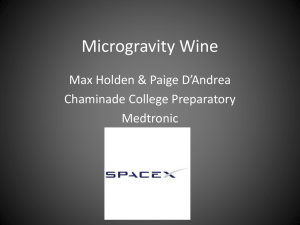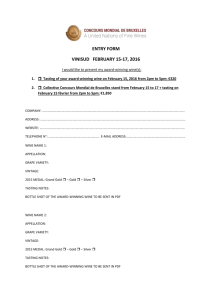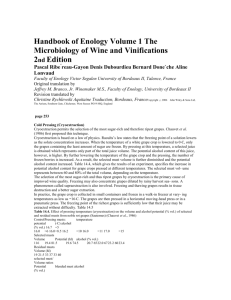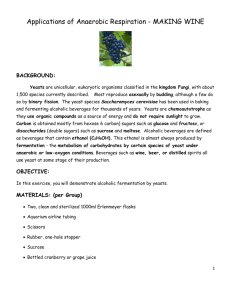Materials - Science in School
advertisement
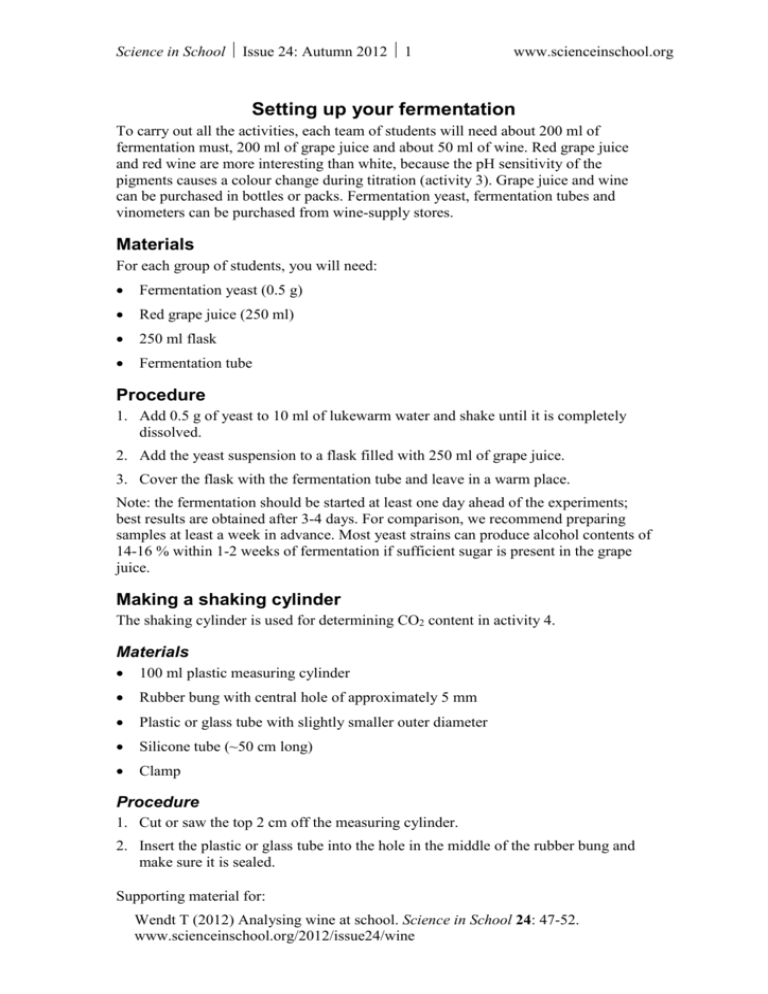
Science in School Issue 24: Autumn 2012 1 www.scienceinschool.org Setting up your fermentation To carry out all the activities, each team of students will need about 200 ml of fermentation must, 200 ml of grape juice and about 50 ml of wine. Red grape juice and red wine are more interesting than white, because the pH sensitivity of the pigments causes a colour change during titration (activity 3). Grape juice and wine can be purchased in bottles or packs. Fermentation yeast, fermentation tubes and vinometers can be purchased from wine-supply stores. Materials For each group of students, you will need: Fermentation yeast (0.5 g) Red grape juice (250 ml) 250 ml flask Fermentation tube Procedure 1. Add 0.5 g of yeast to 10 ml of lukewarm water and shake until it is completely dissolved. 2. Add the yeast suspension to a flask filled with 250 ml of grape juice. 3. Cover the flask with the fermentation tube and leave in a warm place. Note: the fermentation should be started at least one day ahead of the experiments; best results are obtained after 3-4 days. For comparison, we recommend preparing samples at least a week in advance. Most yeast strains can produce alcohol contents of 14-16 % within 1-2 weeks of fermentation if sufficient sugar is present in the grape juice. Making a shaking cylinder The shaking cylinder is used for determining CO2 content in activity 4. Materials 100 ml plastic measuring cylinder Rubber bung with central hole of approximately 5 mm Plastic or glass tube with slightly smaller outer diameter Silicone tube (~50 cm long) Clamp Procedure 1. Cut or saw the top 2 cm off the measuring cylinder. 2. Insert the plastic or glass tube into the hole in the middle of the rubber bung and make sure it is sealed. Supporting material for: Wendt T (2012) Analysing wine at school. Science in School 24: 47-52. www.scienceinschool.org/2012/issue24/wine Science in School Issue 24: Autumn 2012 2 www.scienceinschool.org 3. Attach silicone tubes at least 20 cm long to both ends of the tube. 4. Insert the bung into the top of the cylinder. The silicone tube on the inside should almost reach the bottom of the cylinder, and the tube on the outside should be at least 20 cm long 5. Fix a removable clamp to the outside tube to seal it. Supporting material for: Wendt T (2012) Analysing wine at school. Science in School 24: 47-52. www.scienceinschool.org/2012/issue24/wine Science in School Issue 24: Autumn 2012 3 www.scienceinschool.org Activity 1a: determining sugar content using a pycnometer The amount of sugar in the grape juice will determine both the alcohol content and the sweetness of the finished wine. In this activity, you will estimate sugar content by measuring the density with a pycnometer, or specific gravity bottle. By measuring the empty and filled weights of the pycnometer, the density of the liquid can be calculated. Materials Pycnometer with stopper Balance 20 % (by weight) sucrose solution Grape juice Pipette Paper towels Procedure 1. Weigh the empty pycnometer and stopper and note the weight. 2. Fill the pycnometer right to the top with 20 wt% sucrose solution. Insert the stopper (some liquid will escape through the capillary). Wipe off any spilled liquid and weigh the filled pycnometer. 3. Repeat the measurement with grape juice. 4. Calculate the density: density = (filled weight – empty weight) / volume Where density is measured in g/ml; filled and empty weight in g; and volume in ml. Example: the pycnometer has a calibrated volume of 25.687 ml (provided by the manufacturer). The liquid has a weight of 27.15 g. Therefore, the density is 27.15 / 25.687 = 1.057 g/ml. 5. Use the density to calculate must weight, sugar concentration and possible alcohol yield using the equations below and enter the data into table 1a. The must weight is calculated by: must weight = (density – 1) x 1000 Where must weight is measured in °Oe and density in g/l. The possible alcohol yield is calculated by: possible alcohol yield (in % volume) = must weight (in °Oe) x 0.1267 Example: if the density is 1.057 g/ml then the must weight is (1.057-1) x 1000 which corresponds to 57 °Oe. This can yield up to 7.2 % alcohol by volume. Supporting material for: Wendt T (2012) Analysing wine at school. Science in School 24: 47-52. www.scienceinschool.org/2012/issue24/wine Science in School Issue 24: Autumn 2012 4 20 wt% sucrose www.scienceinschool.org Grape juice Must weight (°Oe) Sugar concentration (°Bx) Possible alcohol yield (vol%) Table 1a: Calculation of sugar content of samples Questions 1. How accurate was your result for the sucrose solution compared to the expected value? 2. How reproducible were your measurements? Compare your measurement to that of the other groups. 3. If you carried out activity 1 as well, how comparable were your results for the two methods (density versus refractometry)? 4. A typical wine has about 12 vol% alcohol. Estimate how much sugar needs to be added to the grape juice to obtain 12 vol% alcohol. Supporting material for: Wendt T (2012) Analysing wine at school. Science in School 24: 47-52. www.scienceinschool.org/2012/issue24/wine Science in School Issue 24: Autumn 2012 5 www.scienceinschool.org Activity 4: determining the carbon dioxide content To measure the progress of the fermentation, we can determine the concentration of either the starting component (glucose) or the products (carbon dioxide and alcohol). The carbon dioxide content is also an important measure when producing sparkling wine. In this activity you will compare the carbon dioxide content of the grape juice, fermenting must and finished wine using a simple homemade version of a VeitsHöchstheimer shaking cylinder. Materials Veits-Höchstheimer shaking cylinder 100 ml each of grape juice, fermenting must and wine Procedure 1. Without shaking, fill the Veits-Höchstheimer shaking cylinder carefully with 100 ml of grape juice by letting the liquid run down the inside of the cylinder. 2. Seal the cylinder with the bung and fasten the clamp. 3. Hold the bung and clamp and shake carefully (see image below). The carbon dioxide will be released from the liquid and will increase the pressure in the cylinder. Hold the cylinder over the sink and open the clamp carefully. The pressure that has built up will cause some liquid to be expelled. 4. Repeat this 3-4 times until no more liquid is expelled. 5. Measure the final volume of liquid in the cylinder and determine the carbon dioxide content using graph 1. Enter your results in table 4. 6. Repeat steps 1-5 with the must and the wine. Caution: Grape juice and must are extremely sweet and sticky. Try not to spill them. Using the shaking cylinder Image courtesy of experimenta Supporting material for: Wendt T (2012) Analysing wine at school. Science in School 24: 47-52. www.scienceinschool.org/2012/issue24/wine Science in School Issue 24: Autumn 2012 6 www.scienceinschool.org Graph 1: Standard curve to determine CO2 content Image courtesy of experimenta CO2 content (g/l) Grape juice Must Wine Table 4: CO2 content of the samples Example: The volume of must after shaking is 65 ml, corresponding to approximately 1.56 g/l of dissolved carbon dioxide. Two molecules of carbon dioxide (MW = 46 g/mol) and two molecules of ethanol (MW = 46 g/mol) are produced by the fermentation process from one molecule of glucose. Therefore 1.56 g/l carbon dioxide and 1.64 g/l ethanol are produced by fermentation of 3.2 g/l sugar. This means from the grape juice, which has a sugar concentration of 15-20 %, only 3.2 % is dissolved as carbon dioxide in the must. Questions 1. Determine the amount of dissolved carbon dioxide in your sample. 2. Calculate the amount of sugar that this relates to. 3. Calculate the percentage of carbon dioxide that remains in solution compared to the total carbon dioxide produced. Supporting material for: Wendt T (2012) Analysing wine at school. Science in School 24: 47-52. www.scienceinschool.org/2012/issue24/wine Science in School Issue 24: Autumn 2012 7 www.scienceinschool.org Activity 5: cloudiness and fining Several substances, particularly proteins, can cause cloudiness and must be removed in a process called fining before wine is sold. This is most easily done by adding an aqueous suspension of siliceous earth, which binds the protein and can be removed by sedimentation. The cloudiness is measured before and after treatment using a photometer at a wavelength of 630 nm. The cloudier the solution, the less light is transmitted and the lower the reading on the spectrophotometer. Materials Pipette 2 ml centrifuge tube Table-top centrifuge Suspension of siliceous earth (100 g/l) Photometer (set to 630 nm wavelength) 5 ml each of grape juice, unfiltered must, filtered must and wine Procedure 1. Pipette 1.9 ml of filtered must into a 2 ml centrifuge tube. 2. Add 0.1 ml freshly shaken aqueous siliceous earth suspension and mix vigorously. 3. Centrifuge at top speed for 2 min. The supernatant is your fined must. Note: make sure to balance the sample in the centrifuge (e.g. with a tube of water). 4. Take four spectrophotometer cuvettes and fill them with grape juice, unfiltered must, filtered must and fined must, respectively. 5. Measure the samples in the spectrophotometer at 630 nm and enter the data in table 5. Transmission at 630 nm (%) Grape juice Unfiltered must Filtered must Fined must Wine Table 5: Light transmission before and after fining Questions 1. Do you observe any coloured pellet besides the siliceous earth? Supporting material for: Wendt T (2012) Analysing wine at school. Science in School 24: 47-52. www.scienceinschool.org/2012/issue24/wine Science in School Issue 24: Autumn 2012 8 www.scienceinschool.org 2. Think about long-term storage of the wine. Why do you think fining is carried out? Supporting material for: Wendt T (2012) Analysing wine at school. Science in School 24: 47-52. www.scienceinschool.org/2012/issue24/wine Science in School Issue 24: Autumn 2012 9 www.scienceinschool.org Activity 6: microscopy of fermenting yeast Yeast is a single-celled micro-organism approximately 10 µm in diameter. During the fermentation process, yeast cells import glucose through the cell membrane and, under anaerobic conditions, convert it to ethanol and carbon dioxide. Yeast cells that actively metabolise sugar grow rapidly and reproduce asexually by an asymmetric division process. You can observe this as budding yeast. Materials Must sample Light microscope Slides and cover slips Dropping pipettes Marker pen Procedure 1. Label a glass slide. 2. Shake your sample of must, pipette a small drop onto the glass slide, and cover it with a cover slip as shown in the image below. 3. Examine the sample, starting at the lowest magnification. 4. Draw a sketch of budding yeast cells. Preparation of sample for microscopy. Questions 1. What percentage of the yeast organisms in your sample are budding? 2. How does the percentage of your budding yeast compare with other groups? 3. Describe how this relates to the length of fermentation. Supporting material for: Wendt T (2012) Analysing wine at school. Science in School 24: 47-52. www.scienceinschool.org/2012/issue24/wine
